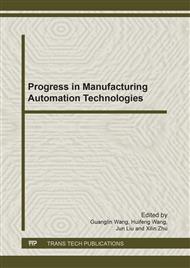p.101
p.107
p.112
p.117
p.122
p.129
p.134
p.140
p.144
Static and Dynamic Characteristic of Cutting Force when High-Efficiency Cutting Ti-6Al-4V
Abstract:
Experiment of cylindrical dry turning Ti6Al4V has been carried out employing coated and uncoated carbide tools to determine the characteristic of cutting force. Force signals have been extracted in the turning processes. The static component value of cutting force has been calculated and fractal behavior of cutting force has been studied by calculating fractal dimension. The results of studies indicate that radial force of static component is higher than the other forces. The static values of cutting force involving T2 (composite coating with TiAlN and AlCrN) and T3 (uncoated carbide) are less than T1 (composite coating with TiCN and Al2O3). The change of static value of cutting force using T2 with increase of cutting speed is smaller than the other tools. Fractal dimension can be used as the characteristic of the randomness of dynamic component of cutting force and reflect stability of cutting process. The fractal dimension of dynamic component of cutting force of T1 is the smallest, followed by the T3, and that of T2 is highest. Considering the static and dynamic characteristic of cutting force, T3 (uncoated carbide tool) is more suitable for high-efficiency cutting Ti6Al4V.
Info:
Periodical:
Pages:
122-128
Citation:
Online since:
July 2011
Authors:
Keywords:
Price:
Сopyright:
© 2011 Trans Tech Publications Ltd. All Rights Reserved
Share:
Citation:


